Popess - Beth
This most elegant of ladies sits atop her noble throne of divine wisdom. In her lap is a tome, on her head is a rather decorative hat, and behind her is a curtain. She provides the correct discipline that guides the numerous forces that look to her for proper order. She is the matriarchal guide of instruction.
The name of the second character of the ancient alphabet is linked to the second hieroglyphic symbol of the Tarot. The original design of this character (pre-1200 B.C.) looks like this...
![]()
The name of this second character (the ancient prototype of the modern letter b) is paired with this second Tarot key. This letter is represented in the ancient alphabet by the word בית, which is formed from a triliteral stem that is composed of the letters ב, י, and ת, and has the basic meaning of “house” and by extension means “family,” “building,” or “temple.”
The Essential Nature of the Popess Hieroglyph
The primary theme of this iconic image represents the actual building of knowledge. When this aspect of is further examined, it becomes apparent that knowledge is the ultimate type of building to be built, and this concept perfectly compliments the name of the ancient alphabetic character associated with this iconic image. The building takes numerous forms, including the construction of the mind gained by natural observation of phenomena as well as using as a foundation that has been used by others at some point in the past. There is also the building that occurs when one takes this type of empirically gained knowledge and teaches it to others.
This feminine representation of the right-handed active side of the intellect appears in nature as the motherly instinct to intruct the young of the species. Thus, the well known phenomenon of motherly instruction in all of its numerous forms and occurences more than justifies the feminine qualities of this active right-handed side of the intellect displayed on this icon of the Tarot. This would also aid in the balancing of the destructive qualities of the left-handed side of this type of energy.
The Popess of the Tarot de Marseilles
As presented by the Tarot de Marseilles, the Popess trump changes little, if any, over the centuries as can be seen by the chronologically arranged versions below. As a general observation, if there are any discrepancies between the versions, they usually occur with the Noblet version, which is also the oldest (far left). However, with this particular trump, the different versions all present the same basic componenents with very little variations occuring over the centuries.
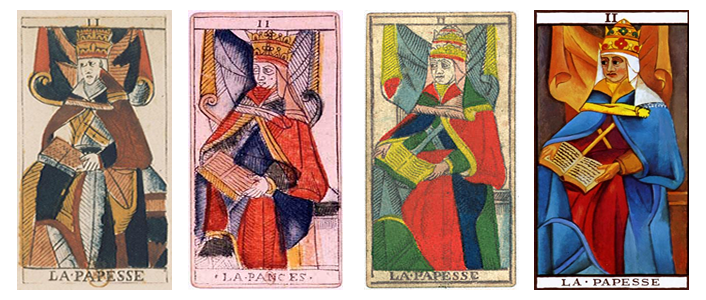
The central figure is seated and holding an open book. There are curtains behind her head and shoulders, and the lower portion of the chair upon which she is seated can be seen. The crown atop her head is two-layered, and she faces towards her right. The one slight difference in the Noblet version is the miniature crosses that adorn the garment she wears. They are found just above the book in her lap and her visible hand. Also the right hand of the Popess can be seen in the Conver image. It is not visible in the Noblet or Dodal versions.
The Rider-Waite Interpretation of the Popess
The Rider-Waite Tarot adds a lot of symbolism to this Tarot icon by placing a good deal of additional iconic supplements to the basic image presented in the Marseilles Tarot. A. E. Waite in the accompanying text says, “She has the lunar crescent at her feet, a horned diadem on her head, with a globe in the middle place, and a large solar cross on her breast. The scroll in her hands is inscribed with the word Tora, signifying the Greater Law, the Secret Law and the second sense of the Word. It is partly covered by her mantle, to shew that some things are implied and some spoken. She is seated between the white and black pillars – J. and B. – of the mystic Temple, and the veil of the Temple is behind her: it is embroidered with palms and pomegranates. The vestments are flowing and gauzy, and the mantle suggests light – a shimmering radiance. She has been called occult Science on the threshold of the Sanctuary of Isis, but she is really the Secret Church, the House which is of God and man. She represents also the Second Marriage of the Prince who is no longer of this world; she is the spiritual Bride and Mother, the daughter of the stars and the Higher Garden of Eden. She is, in fine, the Queen of the borrowed light, but this is the light of all. She is the Moon nourished by the milk of the Supernal Mother.
In a manner, she is also the Supernal Mother herself – that is to say, she is the bright reflection. It is in this sense of reflection that her truest and highest name in bolism is Shekinah – the co-habiting glory. According to Kabalism, there is a Shekinah both above and below. In the superior world it is called Binah, the Supernal Understanding which reflects to the emanations that are beneath. In the lower world it is MaIkuth – that world being, for this purpose, understood as a blessed Kingdom that with which it is made blessed being the Indwelling Glory. Mystically speaking, the Shekinah is the Spiritual Bride of the just man, and when he reads the Law she gives the Divine meaning. There are some respects in which this card is the highest and holiest of the Greater Arcana.”
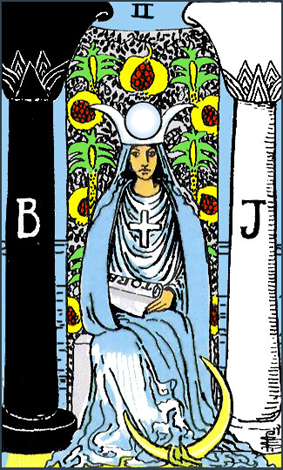
The Rider-Waite Tarot takes an interesting approach to this Tarot trump and adds many new dimensions to it. First, the Rider-Waite Tarot attaches the symbol of the Lunar crescent and attempts to directly draw an association of the high priestess with the realms of silver. Next, the central subject of this hieroglyphic icon is placed between the two pillars of Solomon's Temple. The upper case English letters B and J are used to identify the twin pillars of בעז and יכין, respectively. The pillar of the first is black while the pillar of second is white. The Rider-Waite version also has the word TORA inscribed on the document resting on her lap. Since the basic meaning of this word is instruction, it is quite appropriate that it be used here. There are pomegranates and palms on the veil hanging behind her, and the crown on her head sports an orb along with a crescent shaped set of horns. With the mixed Christian, Masonic, and Pagan symbolisms all expressed within the Rider-Waite version of this hieroglyphic icon, there are numerous symbols from many different traditions that all meet in the central theme of the spiritual feminine powers of construction and creativity, which is the prevalent definition of the word בית.
In a fascinating display of basic colour with ancient tradition, the black pillar of בעז is on the left side of the image; however, it is on the right side of the priestess. The white pillar of יכין is on the right side of the image, but on the left side of the priestess. This could be speculated two ways – either the creators intended this dual polar nature to be present, or it was not intended and was a mere accidental occurrence. In order to better explore this predicament, it might be prudent to review the actual definitions of the terms associated with the pillars themselves.
The word בעז is formed from a Chaldean root not used anywhere else in the scriptures and has the basic definition of “to be nimble” or “quick;” thus, the term could be seen as an overall expression of artifice and dexterity that has been developed to a high degree. The word יכין is found throughout the Masoretic texts and is formed from the related biliteral root of נ and either כ or ק, which expresses the concepts of “to set up,” “to establish,” “to possess,” “to acquire,” and “to purchase.” The etymological derivative of this biliteral root can be seen in the English word gain. This root is also the etymological foundation for the modern English words king and queen. Also, this root is used as a name for the Hebrew priests of the tribe of Levi – in the sense of those who establish and set up the law – and can be seen in the modern surname of Cohen. The root is also used to form the word Cain, which is the name of the second child of Adam and Eve.
* * *
BACK * INDEX * NEXT
 |
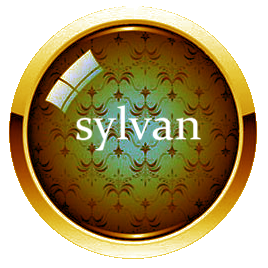 |
 |
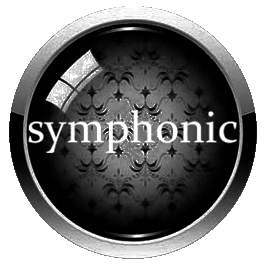 |
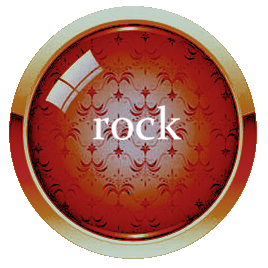 |
 |